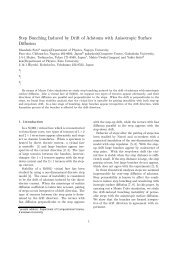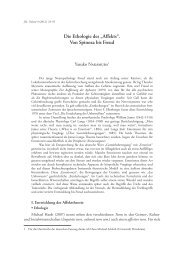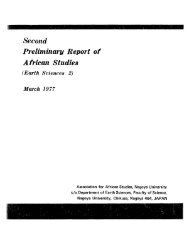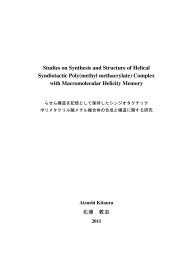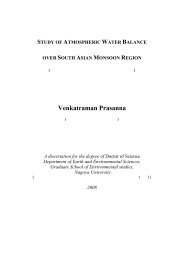k9254.pdf
k9254.pdf
k9254.pdf
Create successful ePaper yourself
Turn your PDF publications into a flip-book with our unique Google optimized e-Paper software.
2.2.2. Synthesis procedure of the ATRP initiator.<br />
Propargyl 2-chloropropionate (PCP) was used as a free ATRP initiator. PCP was synthesized<br />
by an esterification reaction of propargyl alcohol with 2-chloropropionyl chloride in presence of<br />
dry trimethyl amine and THF (Figure 2-3 (a)). A typical procedure was as follow.<br />
Air was removed from a 250 ml round –bottom flask by freeze/pump/thaw cycle and the flask<br />
was charged with trimethyl amine (1.98ml), propargyl alcohol (1.98 ml) and dry THF (40 ml).<br />
The reaction mixture was cooled to 0 o C in an ice-water bath. 2-chloropropionyl chloride (3.37<br />
ml) was added dropwise over a period of 1hour under continuous magnetic stirring. Then the<br />
mixture was stirred at 0 o C for 1 hour and at room temperature whole night. The mixture was<br />
diluted with n-hexane (equivalent amount of THF volume) and washed with 10% HCl solution,<br />
NaHCO3, brine and miliQ water. To remove water from the mixture, dried MgSO4 was added<br />
and kept it over night. After removing MgSO4 by filtration, the filtrate was concentrated and then<br />
further purified by silica gel column chromatography using a mixture of n-hexane: ethyl acetate<br />
= 9:1 as the eluent. Then the solvent was removed by rotary evaporator and residue was distilled<br />
under reduced pressure. A colorless liquid was obtained with 74% yield. 1 H NMR (Figure 2-3<br />
(b)) (CDCl3, δ, ppm): 4.86 (2H, -CH2O-), 4.42 (H, -CHCl-), 2.53 (H, -C≡CH), and 1.695 (3H, -<br />
CH3).<br />
2.2.3 ATRP of NIPA in bulk solution and on surface of ATRP initiator layer.<br />
Scheme 2-4 shows the preparation of PNIPA brushes on silicon surface. Formation of self-<br />
assembled monolayer was discussed above. The polymerization was carried out as follows: A<br />
Schlenk tube was charged with NIPA (1.65 gm,) as a monomer. 3ml dimethylsulfoxide (DMSO)<br />
was added with monomer inside glove box. The solution was degassed by three consecutive<br />
freeze/pump/thaw cycles and backfilled with nitrogen gas (procedure repeated three times). Then<br />
the tube was again charged with copper chloride (3.6 mg,), Me6TREN (10.03 μl,) and PCP (3.6<br />
μl). A silicon substrate with self-assembled monolayer was inserted into the solution of the tube<br />
very carefully under a nitrogen atmosphere. The tube was then sealed with stopper by using<br />
aboratory film paper. The grafting process was carried out at 20 o C with continuous shaking by a<br />
shaker (Model: EYELA, NTS-4000) at different pre-planned time. After desired time period<br />
30



